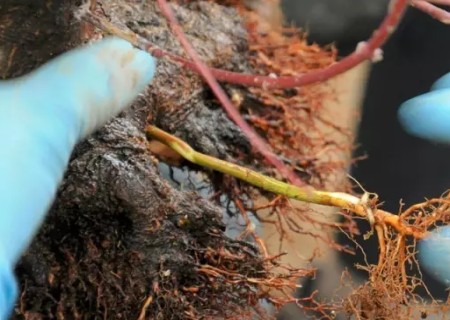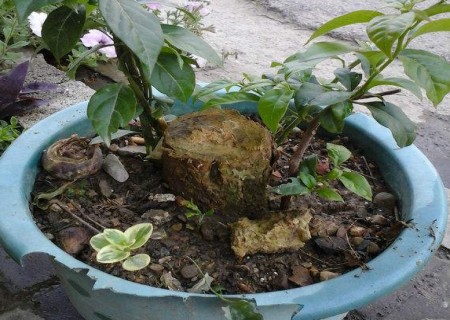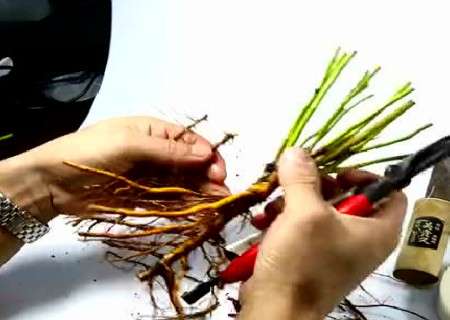Bonsai root grafting technology
For potted plant appreciators, the root is an important factor in determining the sense of stability and age. Therefore, the terms "one plate", "second stem" and "three branches" are popular in the potted industry. Expose the thick roots of the ground, take the stem as the center, extend evenly in all directions in a horizontal way, and closely combine with the ground, so that it is a good way of root disk. The longer the pot is cultivated, the more beautiful the root plate will be, so the age and age of the pot tree can be judged by the root plate.
Root is the basis of tree growth, without root growth, there will be no other parts of the growth. After the root system of the stump is first formed, the root should be often refined. Bonsai plants should be placed in the full-day sun, strengthen the light, increase fertilization, watering, dry and wet alternately. Especially in summer, we should often have a dry state, so that the roots seek development, and the roots will grow a lot. If there is an adequate supply of water for a long time, the leaves will grow wildly and the roots will not grow very well.

What if the bonsai is rootless? Let's take a look at the root grafting method of grafting seedlings.
1. Splicing method:
If the branches of the root system are strong, the wall splitting method can be used. Cut the slant of 3.3 cm on both sides of the branch, grab it on one side, and insert it into the notch of the root system.
2. Inverted connection method:
If the branch is better than the root, use the inverted oblique cutting method. First cut a vertical cut from the middle of the branch, 3.3 cm deep, and then cut the root system into a slope of 3.3 cm on each side, and insert the root system into the cut of the branch.
No matter which method is used, align the cambium of the root system, and then seal the wound with yellow mud or wax. When the number of grafting is large, the grafted semi-mature seedlings are buried in the ditch, which is about 1 meter deep and 0.5 meters wide. The petal length can be determined according to the number of seedlings. The bottom of the ditch is covered with a layer of wet sand, covered with 3.3 cm thick fine sand. If there is a large amount of grafting, it can be buried in the vegetable cellar with wet sand. Before and after the "Grain Rain" festival in the spring of the following year, semi-mature seedlings were planted in the nursery. This method is very suitable for grafting mulberry, apple and pear trees, and the survival rate is about 85%.
The invention relates to a method for cultivating bonsai with roots, and the steps are as follows:
1) choose the trunk or branch on the growing tree, peel the lower part of the trunk or branch in a ring, and cut off the sieve tube of the phloem.
2) some developed roots are selected from the roots of the above trees and grafted on the upper part of the peeling mouth.
3) set up a barrel-shaped container at the grafting place, fill the container with nutritious soil, seal the container, open several breathing holes on the wall of the container, and maintain the humidity in the container.
4) grow sturdy roots in the container, cut off the trunk or branch, remove the container, plant it in a pot, reshape the trunk or branch, and maintain it for 20-30 days.
The technology belongs to the technical field of bonsai cultivation method, in particular to a bonsai root grafting cultivation method, which solves the problems of long time and high consumption of manpower and material resources in traditional bonsai cultivation.
Time: 2019-06-10 Click:
- Prev

Old Branch cutting technique of Prunus mume with Bonsai Tree stump
Triangular plum is a tropical ornamental flower suitable for beginners to grow. It is relatively easy for friends in the south to raise triangular plum, especially those in the south, who can live if they are randomly planted in the courtyard. You can see the triangular plum growing into a large flower tree in some small courtyards or fences, and even the triangular plum climbing to the fourth or fifth floor.
- Next

Root grafting technique of Rose-- Root grafting method of bare Root seedlings
Speaking of root grafting, we need to talk about grafting first. Why? Because root grafting belongs to the two ways of grafting, branch grafting and bud grafting. Grafting is one of the methods of artificial vegetative propagation of plants. That is, the branch or bud of one plant is grafted onto the stem or root of another plant.
Related
- Fuxing push coffee new agricultural production and marketing class: lack of small-scale processing plants
- Jujube rice field leisure farm deep ploughing Yilan for five years to create a space for organic food and play
- Nongyu Farm-A trial of organic papaya for brave women with advanced technology
- Four points for attention in the prevention and control of diseases and insect pests of edible fungi
- How to add nutrient solution to Edible Fungi
- Is there any good way to control edible fungus mites?
- Open Inoculation Technology of Edible Fungi
- Is there any clever way to use fertilizer for edible fungus in winter?
- What agents are used to kill the pathogens of edible fungi in the mushroom shed?
- Rapid drying of Edible Fungi

